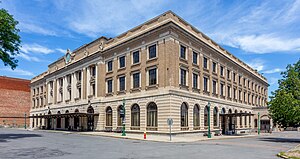
The Lake Shore Limited is an overnight passenger train operated by Amtrak between Chicago and the Northeastern United States, with sections to New York City and Boston. The central segment of the route runs along the southern shore of Lake Erie.

Tower City Center is a large mixed-use facility in Downtown Cleveland, Ohio, on its Public Square. The facility is composed of a number of interconnected office buildings, including Terminal Tower, the Skylight Park mixed-use shopping center, Jack Cleveland Casino, Renaissance Cleveland Hotel, Chase Financial Plaza, and Tower City station, the main hub of Cleveland's four RTA Rapid Transit lines.

The Delaware, Lackawanna and Western Railroad, also known as the DL&W or Lackawanna Railroad, was a U.S. Class 1 railroad that connected Buffalo, New York, and Hoboken, New Jersey, and by ferry with New York City, a distance of 395 miles (636 km). The railroad was incorporated in Pennsylvania in 1853, and created primarily to provide a means of transport of anthracite coal from the Coal Region in Northeast Pennsylvania to large coal markets in New York City. The railroad gradually expanded both east and west, and eventually linked Buffalo with New York City.

Dearborn Station was, beginning in the late 1800s, one of six intercity train stations serving downtown Chicago, Illinois. It remained in operation until May 1, 1971. Built in 1883, it is located at Dearborn and Polk Streets, to the south of the Loop, adjacent to Printers Row. The station was owned by the Chicago & Western Indiana Railroad, which itself was owned by the companies operating over its line. The station building headhouse now houses office, retail, and entertainment spaces, and its trackage yard, behind the headhouse, was redeveloped into part of the Dearborn Park neighborhood.

Newark Penn Station is an intermodal passenger station in Newark, New Jersey. One of the New York metropolitan area's major transportation hubs, Newark Penn Station is served by multiple rail and bus carriers, making it the seventh busiest rail station in the United States, and the fourth busiest in the New York City metropolitan area.

The Morristown Line is an NJ Transit commuter rail line connecting Morris and Essex counties to New York City, via either New York Penn Station or Hoboken Terminal. Out of 60 inbound and 58 outbound daily weekday trains, 28 inbound and 26 outbound Midtown Direct trains use the Kearny Connection to Penn Station; the rest go to Hoboken. Passengers can transfer at Newark Broad Street or Summit to reach the other destination. On rail system maps the line is colored dark green, and its symbol is a drum, a reference to Morristown's history during the American Revolution.
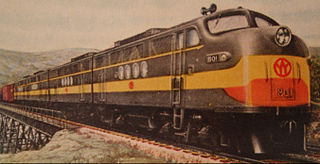
The New York, Ontario and Western Railway, commonly known as the O&W or NYO&W, was a regional railroad founded in 1868. The last train ran from Norwich, New York to Middletown, New York in 1957, after which it was ordered liquidated by a U.S. bankruptcy judge. It was the first notable U.S. railroad with its mainline entirely abandoned.
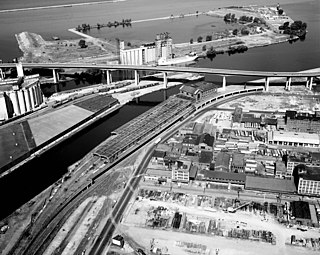
The Metro Rail Maintenance Yard or "South Park Terminal" houses Buffalo Metro Rail's cars in a train shed at the former Delaware, Lackawanna and Western Railroad terminal in the Cobblestone District of Buffalo, New York. The property is located at the southernmost fringe of the Central Business District. The station was built in 1917, and was designed to handle both steam trains and steamships. The storage and maintenance facility was converted to its present condition in 1982, following the demolition of the former main terminal concourse building "headhouse" of the DL&W Terminal in 1979.

Rhinecliff station is an Amtrak intercity rail station located in the Rhinecliff hamlet of Rhinebeck, New York, United States. The station has one low-level island platform, with a wheelchair lift for accessibility. It is served by the Adirondack, Berkshire Flyer, Empire Service, Ethan Allen Express, Lake Shore Limited, and Maple Leaf.

Morristown station is a NJ Transit rail station on the Morristown Line, located in Morristown, in Morris County, New Jersey, United States. It serves an average of 1,800 passengers on a typical weekday. Construction of the historic station began in 1912 and the facility opened November 3, 1913. A station agent and waiting room are available weekdays. The station's interior was featured in Cyndi Lauper's "Time After Time" video in 1984. Just west of the station, at Baker Interlocking, the Morristown and Erie Railway branches off the NJT line. The M&E's offices and shop are here.

Newark Broad Street station is a New Jersey Transit commuter rail and light rail station at 25 University Avenue in Newark, New Jersey. Built in 1903, the station's historic architecture includes an elegant clock tower and a brick and stone façade on the station's main building. In June 1984, the station was added to the National Register of Historic Places in recognition of its historical significance.

The William F. Walsh Regional Transportation Center (RTC) is an Amtrak intermodal transit station serving the Syracuse area. It is owned and operated by Intermodal Transportation Center, Inc, a subsidiary of Centro, and is also served by Greyhound Lines, Megabus, and Trailways. Local and regional bus transportation is provided by Centro. Various taxi firms provide service to the Center, as well.

Rome station is a Neoclassical train station served by Amtrak. It is located on 6599 Martin Street in Rome, New York between the NY 26-49-69 bridge and Mill Road south of the Erie Canal.

Buffalo–Exchange Street station is an Amtrak station in Buffalo, New York. The station serves six Amtrak trains daily: two daily Empire Service round trips between Niagara Falls and New York City and one Maple Leaf round trip between Toronto and New York City. There is also daily Amtrak Thruway bus service at the station, operating between the Buffalo Metropolitan Transportation Center and Jamestown station in Jamestown, New York, via Dunkirk and Fredonia, and serving the communities along the southeast shore of Lake Erie.

Martin Luther King Jr. Plaza is the main passenger rail and intercity bus station of Toledo, Ohio.
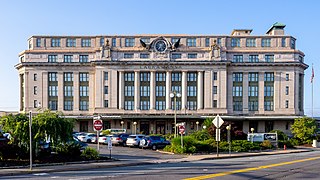
The Radisson Lackawanna Station Hotel, which was built as the Delaware, Lackawanna and Western Railroad Station, is a French Renaissance-style building in Scranton, Pennsylvania.

Elkhart station is a train station in Elkhart, Indiana, served by Amtrak's Capitol Limited between Chicago and Washington D.C, and Lake Shore Limited between Chicago and New York City/Boston. While the station has a waiting room, it is only open in early mornings and late evenings, half an hour before the first westbound and eastbound train arrives. It does not have a ticket agent, but the station does have personnel that can assist riders upon departure and arrival. The station is directly across the tracks from the National New York Central Railroad Museum.
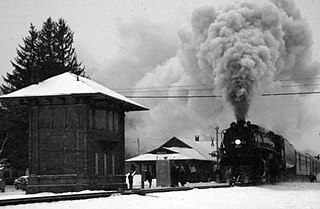
Tobyhanna station is a proposed NJ Transit commuter rail station that is located in Coolbaugh Township, Monroe County, Pennsylvania in the United States. The station forms part of a site owned by a number of public and private entities including the Pennsylvania Northeast Regional Railroad Authority.

West Arlington was a former commuter railroad train station in the Arlington section of Kearny, Hudson County, New Jersey. Located overlooking Passaic Avenue, West Arlington station was one of two in Kearny on the Erie Railroad's New York and Greenwood Lake Railroad, the other one being Arlington at Garafola Place. The station contained two low-level side platforms, with a pair of depots, one of which was on each platform. Trains went from Pavonia Terminal in Jersey City to Wanaque–Midvale station in Wanaque. The next station to the west was North Newark, across nearby WR Draw, a swing bridge over the Route 21, the Passaic River and Passaic Avenue.
The Adirondack Railway was a short-lived tourist railroad which operated in northeastern New York. The company was founded in 1976 to operate a disused railway line owned by New York State since 1974. It operated trains between 1979–1981, including from Utica to Lake Placid, New York, for the 1980 Winter Olympics, before multiple derailments led to the end of service. The route is now operated by the Adirondack Railroad from Utica to Thendara and Big Moose, New York, which will extend service to Tupper Lake by 2022 after New York State completes track renovation northeast from Big Moose: scheduled for November, 2021.
